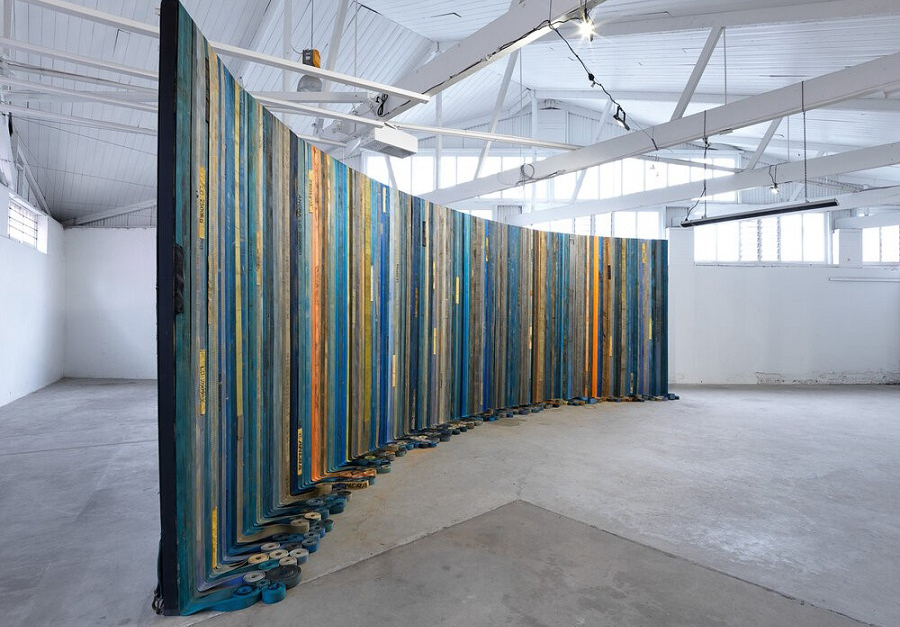Skeer’s art makes processes visible and significant. In works such as those using ratchet ties and other plastic and paper waste, her own processes of synthesis and construction shape the work.
Image: Jane SKEER, True Blue, 2019, used truck rachet straps, steel, timber, acrylic, 300 x 400 x 120cm. Photo: Grant Hancock.
JANE SKEER (SA)
Most of Jane Skeer’s work collects mass-produced detritus of various kinds. Her materials are usually plastics – some bleached pale by the elements, others retaining their manufactured sheen and chroma. Skeer weaves, ties, builds or lays them into new forms. Despite being repurposed, her materials remain distinctively themselves. Her work is, she says, a ‘tribute’ to these resilient, ubiquitous materials that we take for granted. Equally, her work heightens our awareness of the threat that consumerism poses to the natural environment. Skeer used to work a job clearing rubbish from apartment buildings, and she continues to scavenge for many of her materials, giving her an intimate awareness of the scale of waste in our society, an awareness which her work vividly communicates to the viewer.
A number of Skeer’s most impressive works are made of discarded ratchet tie-downs, synthetic textile straps used to secure freight on trucks. She has woven them into mats (Bunbury, Albany, Whyalla, Port Augusta, Alice Springs, Freeling, Adelaide, Millicent, Mount Gambier, Melbourne and Sydney, 2018) and laid them into patterns of horizontal or vertical stripes (Highway 1, 2019). Most strikingly, True Blue, 2020, hangs ties vertically against a ten-metre curved wall. The ties are laid together precisely, creating a taut composition of vertical stripes, the worn blue ties interspersed here and there with a well-placed strap of complementary orange. Where they meet the floor, each is spooled into a tight spiral. The installation is vast-feeling yet finely judged and satisfying in its details. At the heart of True Blue is a sculptural language especially familiar from American post-minimalist sculpture but here applied to the waste of the 21st century. It gives a new life to this detritus, aestheticising it and memorialising it but without renouncing its essentially outcast, abject character.
Another work which is equally satisfying but leavened with humour is Complexity Theory, 2018. Two scavenged Ikea shelving units – the kind of cheaply made furniture destined for landfill sooner rather than later – are filled with waste of a rather higher calibre: copies of the beloved Australian art magazine Artlink. Skeer collected the magazines following a clear-out of Artlink’s offices. The magazines are cut up, shelved and stacked so that each shelving unit is entirely filled. The magazines’ coloured spines – all that is visible of them – turn the budget modernist furniture into two finely tuned geometric abstractions, recalling, a little, the compositions of Sophie Taeuber-Arp. The work is a joyful and apt transfiguration of the commonplace. (Artlink returned the favour, featuring another work of Skeer’s on the cover of its March 2019 issue.)
A few months after the devastating bushfires of 2019–2020 on Kangaroo Island, Skeer took up a residency there. She had lived on the island before, knowing it and its community well. The work she produced during the residency dwelt on the trauma of the fires. In Embedded Landscape, 2020, the series Out of the Ashes, 2020, and Flare Ups, 2021, she scattered charcoal, soot and other debris from the fires over expanses of white paper. The vast size of Embedded Landscape (150 x 460cm) encourages the viewer to step back, suggesting constellations of smouldering matter and smoky, transparent veils. The smaller works draw the viewer in, focusing the eye on the fire’s blackened residue.
Skeer’s art makes processes visible and significant. In works such as those using ratchet ties and other plastic and paper waste, her own processes of synthesis and construction shape the work. These are processes that could go on forever, materials and time permitting, and their end point therefore has a certain arbitrariness too it. But the Kangaroo Island works are shaped by the processes of nature, and these are not constructive but destructive. The work is produced by the devastation of fire. There is only one possible endpoint to that process, and we see it here: scattered, blasted waste. Still, there is another way of seeing these pieces. Most of the detritus Skeer scatters is the burnt, broken leaves of Xanthorrhoea, the slow-growing grass trees that puncture the Kangaroo Island landscape. They are highly resilient plants, their stems protected by densely packed leaf bases, allowing them to live many hundreds of years, even in fire-prone environments. So there is a theme of resilience and a promise of renewal, even in these bleak works of Skeer’s.
Essay by Michael Newall.
Michael Newall is a writer whose work spans philosophy, art history and aesthetics. His book, A Philosophy of the Art School (Routledge, 2021), is out now in paperback. He currently lives and works in Tarntanya/Adelaide.
Jane Skeer works across installation, textiles and photography often incorporating found objects and materials. She graduated from Adelaide Central School of Art with a Bachelor of Visual Arts (Honours) in 2015 and has undertaken residencies and exhibited widely in South Australia for the past five years in solo and group exhibitions. She lives and works in Tarntanya/Adelaide. Artist's website: janeskeer.com

